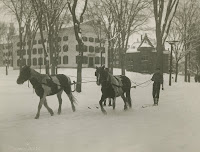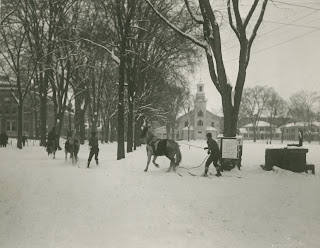
This engraved title page depicting a temple on a hill in a sculpted landscape with formal gardens ushered readers into an equally remarkable book: Lady Mary Wroth's
The First Part of the Countess of Montgomeries Urania (London: Printed for Joh[n] Marriott and John Gismand, 1621). Wroth's
Urania is thought to be the first original work of fiction written by an English woman.
Urania was written in imitation of
The Countess of Pembroke's Arcadia by Wroth's uncle Sir Philip Sidney with a sprawling plot, hundreds of characters, allusions to members of the court, and a character based on Wroth's lover, the third Earl of Pembroke. When it was first published it caused such a scandal that Wroth sought to have it suppressed.
The book ends with another first in English literature: the first published sonnet sequence penned by an English woman.
For more on Lady Mary Wroth and her writing, see the University of Cambridge's
Sidney Homepage. To see
Urania, ask for
Rare Book PR2399.W7 U7 1621. To see the inspiration, ask for Sidney's
Arcadia,
Rauner Hickmott 120.
 Skijoring is a winter sport that likely originated in Scandinavia. The name comes from the Norwegian word skikjøring which means snow driving. Participants in the sport are pulled on skis behind some form of conveyance. This can be dogs, horses or even a motor vehicle. While the practice probably developed as a method of traveling over the snow, it is now primarily performed as a winter sport. Skijoring with dogs generally involves a single skier being pulled by one or more dogs. When using horses, skijoring can either be a skier directing a horse or team of horses from behind, or a rider towing the skier much as a motorboat tows a water skier.
Skijoring is a winter sport that likely originated in Scandinavia. The name comes from the Norwegian word skikjøring which means snow driving. Participants in the sport are pulled on skis behind some form of conveyance. This can be dogs, horses or even a motor vehicle. While the practice probably developed as a method of traveling over the snow, it is now primarily performed as a winter sport. Skijoring with dogs generally involves a single skier being pulled by one or more dogs. When using horses, skijoring can either be a skier directing a horse or team of horses from behind, or a rider towing the skier much as a motorboat tows a water skier. Skijoring became part of Dartmouth's Winter Carnival ski competition in 1916. From images it appears that the races involved both the riderless form and the form with a rider directing the horse. The races were sometimes conducted around the Green, but other times they took place on Tuck Drive or at Memorial Field. Skijoring was part of the Carnival competition until sometime in the late 1930s. It was not a sport of the feint of heart: a note on the back of the image of Henry Doremus '36 wining the 1934 competition states that the other seven contestants fell before completing the circuit.
Skijoring became part of Dartmouth's Winter Carnival ski competition in 1916. From images it appears that the races involved both the riderless form and the form with a rider directing the horse. The races were sometimes conducted around the Green, but other times they took place on Tuck Drive or at Memorial Field. Skijoring was part of the Carnival competition until sometime in the late 1930s. It was not a sport of the feint of heart: a note on the back of the image of Henry Doremus '36 wining the 1934 competition states that the other seven contestants fell before completing the circuit.
